 Nuclear Powered Attack Submarine (SSN-597) (1960-1988)
Nuclear Powered Attack Submarine (SSN-597) (1960-1988)Cold War US Subs
GUPPY | Barracuda class | Tang class | USS Darter | T1 class | X1 class | USS Albacore | Barbel classUSS Nautilus | USS Seawolf | Migraine class | Sailfish class | Triton class | Skate class | USS Tullibee | Skipjack class | Permit class | Sturgeon class | Los Angeles class | Seawolf class | Virginia class
Fleet Snorkel SSGs | Grayback class | USS Halibut | Georges Washington class | Ethan Allen class | Lafayette class | James Madison class | Benjamin Franklin class | Ohio class | Colombia class
USS Tullibee (SSN-597), a unique SSN, second of the name and the smallest in the USN. At 273 feet long, 2,640 tons displacement, she was originally designed in a “hunter-killer” role and then redesignated attack submarine. She had a rich career and conducted many submarine firsts. She notably submerged and surfaced 730 times, travelled 325,000 nautical miles (602,000 km; 374,000 mi) and was retired in 1988. She showed that an “austere” SSN could be built en masse in case the cold war became hot, but if her machinery was very quiet, it was nonetheless not able to procure her enough speed to compete with conventional reactors. Another attempt was made on a stretched Permit class, USS G.P Liscomb, but was not a succes either, nailing the coffin of this perculiar machinery arrangement. #usstullibee #usnavy #nuclearsublarine #coldwar
Development
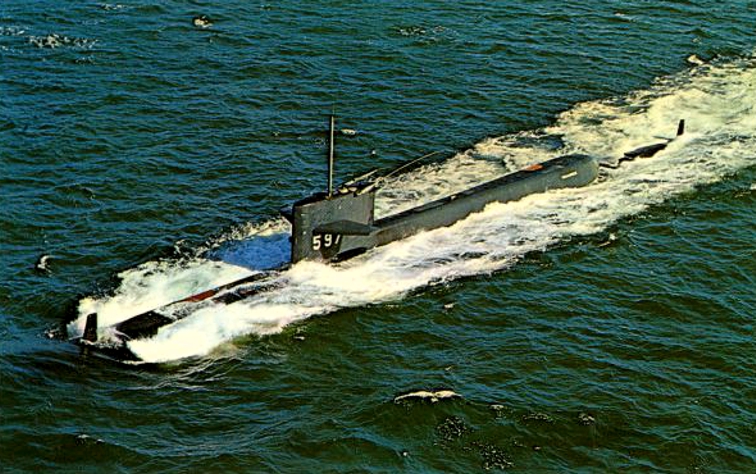
Tullibee is the result of Project Nobska, a 1956 study ordered by Admiral Arleigh Burke, a the time Chief of Naval Operation (CNO). The Committee on Undersea Warfare of the National Academy of Sciences started work on the question of new generation submarines nuclear-powered, and their report pointed at a deeper-diving and much quieter submarine equipped with a long-range sonar for its “hunter-killer” tasks, ambushing noiser soviet submarines.
Project Nobska thus force the USN a bold move in submarine design, with the adoption of a bow-mounted spherical sonar array. This eliminated torpedo tubes, that were relocated amidships. The second major innovation born from the same programme was a brand new turbo-electric transmission powered by the S2C reactor for 2,500 shp (~1,900 kW), which was suspended and built with materials and methods that virtually eliminated all possible vibration. After this, the most difficult part would be to eliminate water rushing in and out of the submarine when changing trim or firing a torpedo. Thus, Tullibee would be an early experimental nuclear-powered submarine (another) but unlike the previous USS Albacore, which tested a new hull shape, she built on that to integrate the first bow sonar/side tubes and set a new standard. The Skipjacks were thus the last US Navy SSNs with bow torpedo tubes.
The contract to build this experimental submarine, soon named USS Tullibee, (a south american white fish), was awarded to the trusted specialist, Electric Boat, now part of General Dynamics, on 15 November 1957. Her keel was laid down in Groton, Connecticut, on 26 May 1958 and she was launched on 27 April 1960. She was christened by Mrs. John F. Davidson, widow of Commander Charles F. Brindupke, CO of USS Tullibee (SS-284) sunk in 26 March 1944. The new USS Tullibee was commissioned on 9 November 1960 under Command of Richard E. Jortberg.
USS Tullibee brought three major innovations to the table but still, was not continued as a concept. It was not indeed cost-effective, with much higher costs than anticipated, and overall performance that paled in comparison of the Thresher class SSNs that followed. The strict hunter-killer submarine concept was thus abandoned and merged into the larger role of attack submarine. The USS Tullibee engineering plant was however remarkable enough to be scaled up and adapted on one Tresher/Permit class later boat, the stretched USS Glenard P. Lipscomb, which was either not completely successful and stayed alone in her class. The latter will be seen as part of the next Tresher/Permit article.
Design of the class
Hull and general design

Compared to the Skipjacks, USS Tullibee had a less streamlined hull, with notably a large protrusion linked to her powerplant installed after of her sail. Other than that, her hull was streamlined perfectly fore and aft, equal in beam and height, but unlike the Skipjacks and Albacore, a relatively long mid-hull section that was straight. This was repeated on the next Tresher-Permit, as it optimized useful space and enabled better modularization, as jumboisation (like for the Liscomb stretching). For her small size she had a rather narrow, elongated hull. She displaced 2,316 long tons (2,353 t) surfaced and 2,607 long tons (2,649 t) submerged for 273 ft in overall length (83 m), 23 ft 7 in (7.19 m) in beam and 21 ft (6.4 m) in draft, probably 28 ft in height overall.
She had no forward diving planes, they were relocated on the sail, and doubling with the cross-tail aft. The crew comprised 6 officers and 60 enlisted. The Tullibee sonar suite included the PUFFS and she displayed three “shark fins”, one forward of the sonar bow, one on top of the aft sail
Powerplant
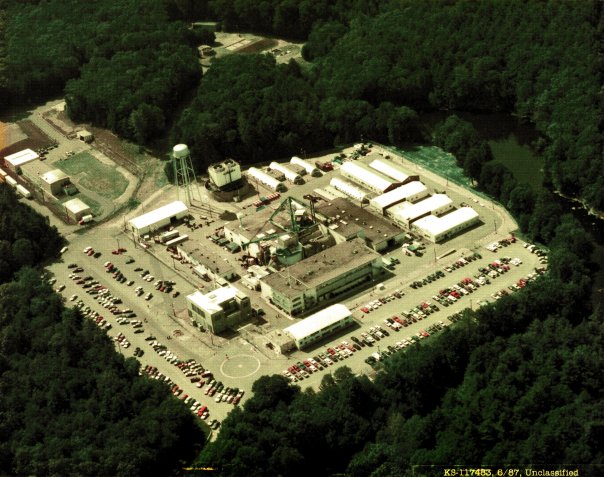
Propulsion comprised the S2C reactor (derived from the land based S1C) coupled with a new, innovative turbo-electric propulsion that nullified vibrations, rated for 2,500 hp (1,900 kW). Top speed was 13 knots (24 km/h; 15 mph) surfaced and 14.8 knots (27.4 km/h; 17.0 mph) submerged in the end, which was not stellar to say the least, especially compared to the Skipjacks. Silent operation did not compensated for the speed loss. The S1C reactor installed on the experimental USS Tullibee (SSN-597) submarine had its “C” standing for Combustion Engineering, the contracted designer.
This nuclear reactor was built in Windsor, Connecticut.
It was a separated type of nuclear reactor, specifically designed for this programme, its power was passed onto steam turbines powered generators in turn powering an electric motor, eliminating reduction gears and thus, associated vibrations. The S1C Prototype nuclear submarine propulsion plant helped testing new equipment and training Naval propulsion operators, until 1993. 14,000 Naval operators went there. The site was reconverted and treated in 2006. The resulting S2C installed on USS Tullibee was very different from the S5W reactor used in most SSNs, and it powered four turbine generators, two being used for DC power (propulsion) and two for AC voltage, all onboard systems as well as the banked rod control. In that case, a single Westinghouse steam turbine generator was coupled with the Combustion Engineering reactor. The electrical operator operated out of the engineering spaces unlike with the S5W. The upper part of the engine imposed the construction of a streamlined structure above the hull, just aft of the sail. This power was passed onto a five bladed fixed pitch propeller.
Armament

Diagram (from facebook), note the location of the torpedo tubes.
The relocation of the torpedo tubes meant only four were adopted to simplify construction, all of the standard 21-inches (533 mm) tubes types to be compatible with models in service. These angled torpedo tubes were not midship as seen later but behind the sonar dome and close to the central operation, forward of the sail.
To see what torpedo models were used, check the Skipjack class.
Sensors
The major gain of the design was to be able to fit a much larger spherical sonar on the bow, which shape was a match in heaven. She had the following suite:
BQQ-2 (BQR-7 + BQS-6) bow sonar:
This model was adopted fist for USS Tullibee and also mounted on the Tresher/Permit class SSNs. It combined an Active BQR-7 and Passive PQS-6 arrays, for Active/Passive Search & Track with an unprecedented range of 74.1 km, well beyond the range of torpedoes.
BQG-1 PUFFS sonars (shark fins):
The Passive Underwater Fire Control Feasibility System program aimed at creating a suite of passive sonar caracterized by distinctive shark-fin PUFFS domes. It was associated with long-range passive detection of targets for the Mark 45 nuclear torpedo and other weapons and saw srervice on many submarines, retrofitted even on some GUPPY class vessels.
BPS-9 radar (sail):
The AN/BPS-9 is is an X-band or I-band surface search radar for submarines, searching for surface contacts and torpedo launching information against surface vessels. It can also be used as a warning radar for incoming low-flying aircraft. It was installed only on USS Ethan Allen (SSBN-608) and USS Tullibee (SSN-597).
Frequency: 8 740 to 8 890 MHz, 8 rpm
pulse repetition frequency (PRF) 540 to 660 Hz
pulsewidth (τ) 0.5 µs
Peak power 50 to 110 kW
Instrumented range 80 NM (≙ 148 km)
Beamwidth 2.6°
WLR-1 ECM suite (sail):
The AN/WLR-1 family superseded the AN/BLR-1 (submarine version – circa 1953) and the AN/SLR-2 (Shipborne Version) receivers in the mid 1960’s. Frequency coverage was from 50 MHz to 10750 MHz across nine bands. The 280’s and IRE’s had an extra band 9 tuner called the AN/SLR-503. Once USS PUEBLO was captured by the Koreans in 1968, the 1A variant was compromised and unclassified. It could indeed be used in Electronic Intelligence Collection. Development of the receiver went on, increasing range to 20,000 MHz.
See also
⚙ specifications USS Tullibee |
|
| Displacement | 2,316 long tons (2,353 t) surfaced, 2,607 long tons (2,649 t) submerged |
| Dimensions | 273 ft x 23 ft 7 in x 21 ft (83 x 7.19 x 6.4 m) |
| Propulsion | Int. Comb. S2C reactor, Westinghouse turbo-electric unit 2,500 hp (1,900 kW) |
| Speed | 13 knots (24 km/h; 15 mph) surfaced, 14.8 knots (27.4 km/h; 17.0 mph) submerged |
| Range | Unlimited |
| Armament | 4 × 21 in (533 mm) torpedo tubes |
| Sensors | BPS-9 radar, BQQ-2 (BQR-7 + BQS-6), BQG-1 PUFFS sonars, WLR-1 ECM suite |
| Crew | 6 officers and 60 enlisted |
Career of USS Tullibee
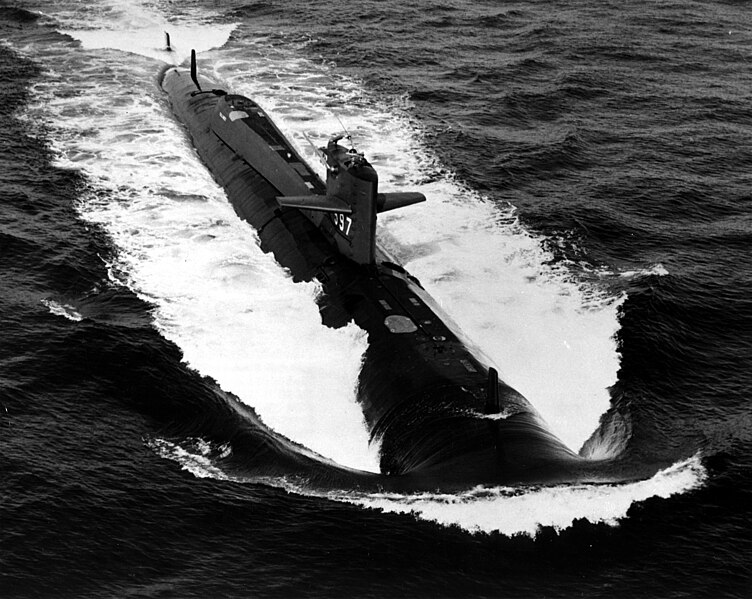
After her shakedown cruise in January 1961, USS Tullibee started sonar evaluations as well as tactical exercises with Submarine Developmental Group 2 off New London, Connecticut, until 1963. She made several trips to Bermuda and San Juan in Puerto Rico. From July 1964, she took part in her first fleet ASW exercise with NATO units. Developmental work resumed by 1965 until the autumn and by 28 October she was homeported to Portsmouth, entering the Shipyard in Kittery for extensive overhaul, over 754 days until 2 January 1968.
Back to New London shame made a refresher cruise in the Caribbean by January 1969 and developmental work in 1970. By 1 August she made her first Mediterranean 6th Fleet deployment. She took part in NATO exercises, stopping in Athens, Naples, Rota, and back to New London on 14 December after some 20,000 miles, 135 days.
In early 1971, she was back in developmental exercises and SSN tactics, stopping at Cape Canaveral, Florida. She took part in a NATO exercise in the western Atlantic and stopped in Halifax, Nova Scotia, being awared a Meritorious Unit Commendation for Mediterranean campaign until 31 October 1970. She would receive the Arleigh Burke Fleet Trophy for significant improvement in battle efficiency and readiness. Operations with the Atlantic Fleet Submarine Force went on until 1974, and she departed New London on 28 April 1975 for her second 6th Fleet Med TOD, back in October for upkeep.
She took part in sonar evaluation tests with the British destroyer HMS Matapan (D43) in the Caribbean by April and June 1976 and entering upkeep again, followed by ASW and local operations until late 1976. By October she was awarded the “Golden Anchor” Award from CINCLANTFLT, for meritorious retention. Sge left New London on 12 November for her third Mediterranean deployment, with 6th fleet and NATO exercises, ongratulated by Commander 6th Fleet with the ASW award “HOOK ‘EM”, spring 1977. She was back on 24 April 1977 for more upkeep cut by short ASW exercises off the east coast. In 1978 she was prepared for her 4th Med TOD, departing in March, but experiencing there a propulsion casualty and two-month repair at Rota, Spain. She was back on 30 August.
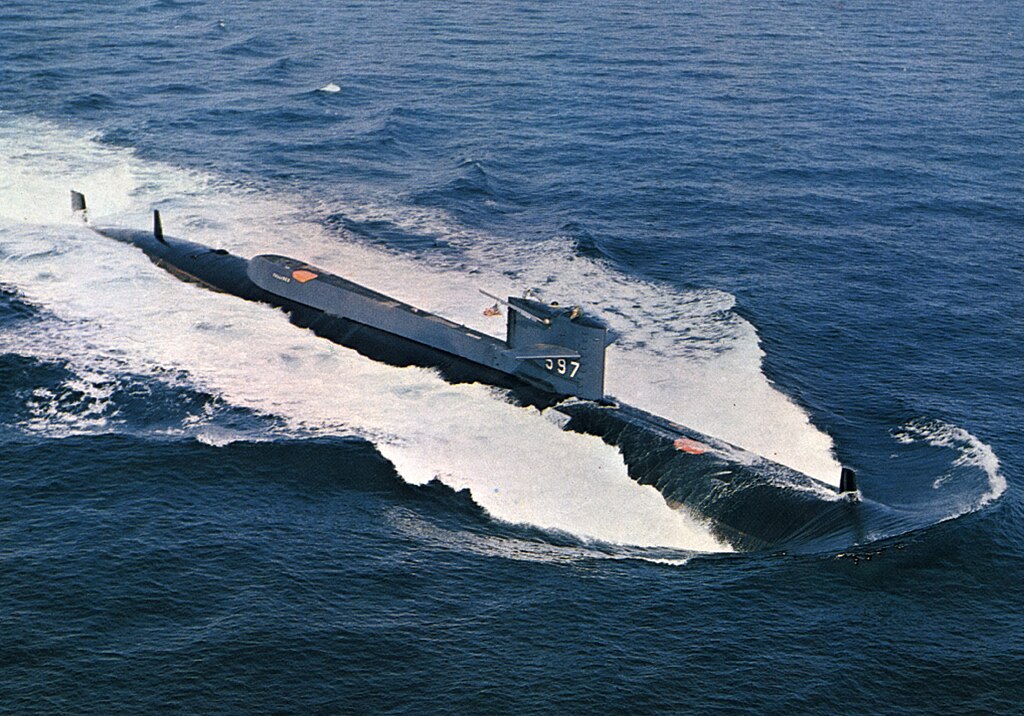
On 24 July 1979, Commander Daniel J. Koczur became her new Commanding Officer and the next month she had her final overhaul at Portsmouth Naval Shipyard, until October 1982 so over 39 months. She multiplied operations and made a refresher training. On 26 April 1983, Commander David W. Candler took command while she experienced engine issues, both in April 1983 and February 1984, spending time in New London for repairs. In November 1985 she made her last Mediterranean deployment. She took part in freedom of navigation exercises, and saw action against Libyan forces, being awarded a Navy Expeditionary Medal and Navy Unit Commendation. She was back home on April 1986 after five months.
On November 1986, Commander Charles R. Skolds took command shile she stayed at the pier in New London in 1986 and 1987, with a few short sorties, pending inactivation. In September 1987 she was towed to Portsmouth for a ten-month inactivation, and then decommission, stricken on 25 June 1988. She was sent to the Nuclear Powered Ship and Submarine Recycling Program from 5 January 1995, completed on 1 April 1996. One of her fairwater planes ended in an art installation at Magnuson Park (Lake Washington, Seattle).
Read More/Src
Books
Naval History and Heritage Command. U.S. Navy.
Friedman, Submarines pp. 110-112
Links
https://www.navypedia.org/ships/usa/us_ss_tullibee.htm
https://man.fas.org/dod-101/sys/ship/eng/index.html
https://www.history.navy.mil/research/histories/ship-histories/danfs/t/tullibee-ii.html
http://www.navsource.org/archives//08/08597.htm
https://en.wikipedia.org/wiki/USS_Tullibee_(SSN-597)

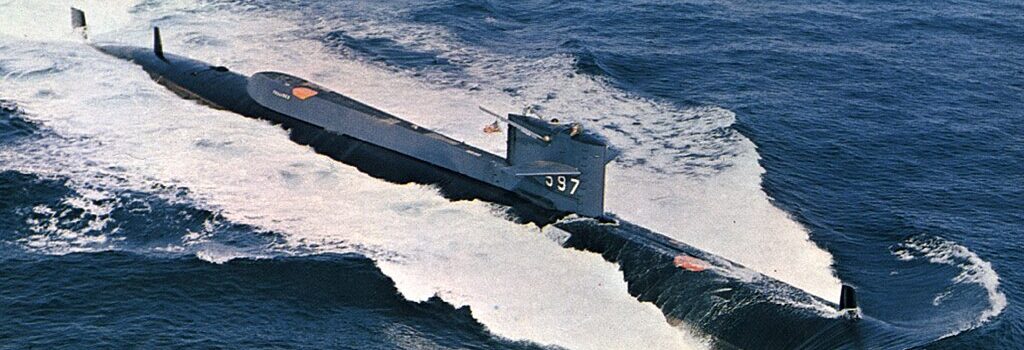
 Latest Facebook Entry -
Latest Facebook Entry -  X(Tweeter) Naval Encyclopedia's deck archive
X(Tweeter) Naval Encyclopedia's deck archive Instagram (@navalencyc)
Instagram (@navalencyc)





 French Navy
French Navy Royal Navy
Royal Navy Russian Navy
Russian Navy Armada Espanola
Armada Espanola Austrian Navy
Austrian Navy K.u.K. Kriegsmarine
K.u.K. Kriegsmarine Dansk Marine
Dansk Marine Nautiko Hellenon
Nautiko Hellenon Koninklije Marine 1870
Koninklije Marine 1870 Marinha do Brasil
Marinha do Brasil Osmanlı Donanması
Osmanlı Donanması Marina Do Peru
Marina Do Peru Marinha do Portugal
Marinha do Portugal Regia Marina 1870
Regia Marina 1870 Nihhon Kaigun 1870
Nihhon Kaigun 1870 Preußische Marine 1870
Preußische Marine 1870 Russkiy Flot 1870
Russkiy Flot 1870 Svenska marinen
Svenska marinen Søværnet
Søværnet Union Navy
Union Navy Confederate Navy
Confederate Navy Armada de Argentina
Armada de Argentina Imperial Chinese Navy
Imperial Chinese Navy Marinha do Portugal
Marinha do Portugal Mexico
Mexico Kaiserliche Marine
Kaiserliche Marine 1898 US Navy
1898 US Navy Sovietskiy Flot
Sovietskiy Flot Royal Canadian Navy
Royal Canadian Navy Royal Australian Navy
Royal Australian Navy RNZN Fleet
RNZN Fleet Chinese Navy 1937
Chinese Navy 1937 Kriegsmarine
Kriegsmarine Chilean Navy
Chilean Navy Danish Navy
Danish Navy Finnish Navy
Finnish Navy Hellenic Navy
Hellenic Navy Polish Navy
Polish Navy Romanian Navy
Romanian Navy Turkish Navy
Turkish Navy Royal Yugoslav Navy
Royal Yugoslav Navy Royal Thai Navy
Royal Thai Navy Minor Navies
Minor Navies Albania
Albania Austria
Austria Belgium
Belgium Columbia
Columbia Costa Rica
Costa Rica Cuba
Cuba Czechoslovakia
Czechoslovakia Dominican Republic
Dominican Republic Haiti
Haiti Hungary
Hungary Honduras
Honduras Estonia
Estonia Iceland
Iceland Eire
Eire Equador
Equador Iran
Iran Iraq
Iraq Latvia
Latvia Liberia
Liberia Lithuania
Lithuania Mandchukuo
Mandchukuo Morocco
Morocco Nicaragua
Nicaragua Persia
Persia San Salvador
San Salvador Sarawak
Sarawak Uruguay
Uruguay Venezuela
Venezuela Zanzibar
Zanzibar Warsaw Pact Navies
Warsaw Pact Navies Bulgaria
Bulgaria Hungary
Hungary

 Bundesmarine
Bundesmarine Dutch Navy
Dutch Navy Hellenic Navy
Hellenic Navy Marina Militare
Marina Militare Yugoslav Navy
Yugoslav Navy Chinese Navy
Chinese Navy Indian Navy
Indian Navy Indonesian Navy
Indonesian Navy JMSDF
JMSDF North Korean Navy
North Korean Navy Pakistani Navy
Pakistani Navy Philippines Navy
Philippines Navy ROKN
ROKN Rep. of Singapore Navy
Rep. of Singapore Navy Taiwanese Navy
Taiwanese Navy IDF Navy
IDF Navy Saudi Navy
Saudi Navy Royal New Zealand Navy
Royal New Zealand Navy Egyptian Navy
Egyptian Navy South African Navy
South African Navy






























 Ukrainian Navy
Ukrainian Navy dbodesign
dbodesign